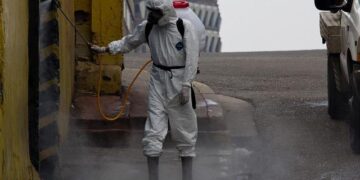In a groundbreaking discovery unveiled by CNN, drone footage has captured orcas employing tools in their natural habitat for the very first time. This remarkable find sheds new light on the intelligence and behavioral complexity of these marine mammals, offering scientists a unique glimpse into their problem-solving abilities. The unprecedented video not only challenges previous assumptions about orca behavior but also opens up exciting avenues for further research into tool use among non-human species.
Drone Footage Captures Orcas Employing Innovative Tool Use in Natural Habitat
In a groundbreaking observation, researchers utilizing high-definition drone technology have documented orcas engaging in a form of tool use previously undocumented in the wild. The footage reveals pods skillfully manipulating kelp and sea sponges, fashioning them into makeshift tools to aid in hunting and social interactions. This behavior showcases a sophisticated level of problem-solving, expanding our understanding of orca intelligence and their ability to adapt to environmental challenges.
The study highlights several distinct techniques observed during the footage:
- Kelp Harnessing: Orcas wrap kelp strands around their rostrums to corral fish into concentrated schools.
- Sponge Poking: Some individuals use sea sponges to disturb sediment, flushing out hidden prey from the ocean floor.
- Collaborative Use: Pods demonstrate coordinated efforts, sharing tools and alternating roles to maximize hunting efficiency.
| Behavior | Tool Used | Purpose |
|---|---|---|
| Kelp Wrapping | Kelp Strands | Fish Herding |
| Sponge Disturbance | Sea Sponges | Prey Flushing |
| Role Switching | Shared Tools | Hunting Efficiency |
Scientists Analyze Behavioral Implications of Tool Use Among Wild Orcas
Recent drone recordings have unveiled groundbreaking evidence of orcas wielding objects in their natural habitat, marking a significant milestone in marine biology. Researchers observed pods using marine sponges as protective tools over their rostrums while foraging along rocky seabeds, an adaptation thought to prevent injury and enhance hunting efficiency. This behavior not only demonstrates remarkable problem-solving skills but also suggests a cultural transmission of knowledge within orca communities, akin to primate tool-use traditions.
Experts emphasize the broader behavioral implications these findings hold, especially regarding social learning and cognitive complexity in cetaceans. The documented tool use challenges prior assumptions about the exclusivity of such behaviors to land animals, opening new avenues for comparative studies on intelligence across species. The following table summarizes key observations from the drone footage:
| Observation | Behavior | Frequency | Pod Location |
|---|---|---|---|
| Sponging | Using sponges as protective covers | High | Coastal Norway |
| Stick Manipulation | Leverage to dislodge prey | Moderate | British Columbia |
| Shell Handling | Use as barriers to trap fish | Low | New Zealand waters |
- Social transmission: Tool use passed through generations, indicating learning within groups.
- Adaptive advantage: Techniques improve hunting success and survival rates.
- Ecological insight: Highlights the orcas’ role as intelligent ecosystem engineers.
Experts Call for Enhanced Marine Protection Measures to Preserve Orca Habitats
Recent discoveries captured through drone technology have shed new light on the complex behaviors of orcas, revealing tool use previously undocumented in these apex predators. This groundbreaking evidence has intensified calls from marine biologists and environmental advocates for stronger protection policies around critical orca habitats. Experts emphasize that the sophistication displayed by orcas in employing natural materials to aid in hunting highlights their ecological intelligence and the urgent need to safeguard the delicate marine ecosystems they inhabit.
Conservationists argue that current measures fall short in addressing threats like pollution, overfishing, and increasing maritime traffic. They are pushing for:
- Expanded marine protected areas (MPAs) encompassing known orca feeding and breeding grounds
- Stricter regulations on shipping routes to reduce noise pollution and collision risks
- Enhanced monitoring programs utilizing drones and underwater sensors to track orca populations and behaviors
| Threat Factor | Current Impact | Proposed Solution |
|---|---|---|
| Noise Pollution | Disrupts communication | Implement quieter ship technology |
| Overfishing | Depletes prey availability | Set sustainable catch limits |
| Chemical Contaminants | Bioaccumulation harms health | Enforce stricter waste controls |
In Summary
The groundbreaking drone footage capturing orcas using tools marks a significant advancement in our understanding of these intelligent marine mammals. This remarkable discovery not only sheds new light on orca behavior but also underscores the growing capabilities of drone technology in wildlife research. As scientists continue to unravel the complexities of animal cognition and tool use, such insights deepen our appreciation of the natural world and highlight the importance of preserving these remarkable creatures and their habitats.






























